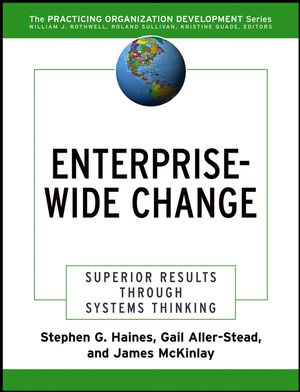Enterprise-Wide Change: Superior Results Through Systems ThinkingISBN: 978-0-7879-7146-5
Paperback
352 pages
October 2004, Pfeiffer
 |
||||||
Preface.
Acknowledgments.
Introduction.
Purpose of this Book.
Organization of the Book.
Special Features.
Part A: Introduction to Systems Thinking and Superior Results.
1. The Fundamentals of Enterprise-Wide Change.
Chapter Purposes.
Welcome to the Future.
The Systems Thinking Approach.
Achieving Superior Results.
The Uniqueness of Enterprise-Wide Change.
21st Century: Revolutionary Worldwide Change and Its Implications.
The Secret of Constant Growth.
75 Percent of All Major Changes Do Not Succeed.
The “Big Three” Enterprise-Wide Failure Issues.
Preview: The Enterprise-Wide Change Journey.
Chapter One Recap.
2. Seeking a Unity of Science for Living Systems.
Chapter Purposes.
Complexity Versus Simplicity: Our Different Views of the World.
The Helicopter View of Life.
Analytic Thinking: A Mindset Left Over from the Industrial Age.
General Systems Theory: The Unity of Science.
Chapter Two Recap.
3. Foundations of the Systems Thinking Approach.
Chapter Purposes.
Systems Concept #1: Seven Levels of Living Systems.
Systems Concept #2: Natural and Predictable Cycles of Change.
Systems Concept #3: The Simplicity of Systems Thinking Is Backwards Thinking.
Systems Concept #4: Twelve Characteristics of Living Systems.
The Whole System: Living Systems Characteristics #1–#6.
The Inner Workings of Systems: Living Systems Characteristics #7–#12.
Some Guiding Principles of Systems Thinking.
Chapter Three Recap.
Part B: Practical Application to Enterprise-Wide Change.
Framework for Part B.
4. Smart Start: Engineering Success Up-Front.
Chapter Purposes.
Chapter Context.
Smart Start: Engineer Success Up-Front.
The Iceberg Theory of Change—Three Realities of Life: Content—Process—Structure.
The Structures of Change Expanded: Tailored to Your Needs.
Structure and Player #1: Change Leaders.
Structure and Player #2: Change Consultants.
Structure and Player #3: Change Implementers.
Structure and Player #4: Program Management Office.
A Menu of Additional Change Infrastructures.
Further Elaboration on Key Structures.
The Game Plan for Enterprise-Wide Change.
Chapter Four Recap.
5. Clarity of Purpose: Working On the Enterprise.
Chapter Purposes.
Chapter Context: Working On the Enterprise.
Missing Element #1: Phase E.
Missing Element #2: Phase A.
Missing Element #3: Phase A.
Missing Element #4: Phase B.
Summary: Clarity of Purpose.
Chapter Five Recap.
6. Assessing the Enterprise as a Living System.
Chapter Purposes.
Chapter Context.
Some Mental Maps for Assessing Enterprises as Living Systems.
Multiple Conflicting Mindsets or Mental Maps (Versus a Totally Integrated Enterprise-Wide Assessment).
One Mental Map of an Organization as a Living System.
A New Enterprise-Wide Assessment Mental Map: A Business Excellence Architecture.
Summary: Enterprise-Wide Assessment and Vital Signs.
Chapter Six Recap.
7. Simplicity of Execution: Working In the Enterprise.
Chapter Purposes.
Chapter Context.
On the Path to Clarity and Simplicity.
Cascading the Changes: Strategies—Initiatives—Tasks—Accountability—Rewards.
Chapter Seven Recap.
8. Wave After Wave of Changes.
Chapter Purposes.
Chapter Context.
Individual Change: The Rollercoaster of Change.
Enterprise-Wide Change and the Rollercoaster of Change.
The Cascade of Change: Wave After Wave.
Seven Natural Rings of Reality: Classifying Mainstream OD Change Interventions.
The Seven Natural Rings of Reality Matrix and the Impact of the Rollercoaster of Change.
Implications for the Enterprise-Wide Change Journey.
Chapter Eight Recap.
9. Sustain Business Excellence.
Chapter Purposes.
The Mid-Course Enterprise-Wide Change Review: Fighting Entropy in Enterprise-Wide Change.
Annual Review of Organizational Capacity.
Chapter Nine Recap.
Enterprise-Wide People Edge Best Practices.
Part C: How to Begin Enterprise-Wide Change.
10. Working on the Enterprise: The Bite-Sized Approach.
Chapter Purpose.
How to Begin: Tailored to Your Needs.
The Results.
Websites.
Bibliography.
About the Series.
Statement of the Board.
Afterword to the Series.
About the Series Editors.
About the Authors.
Index.



